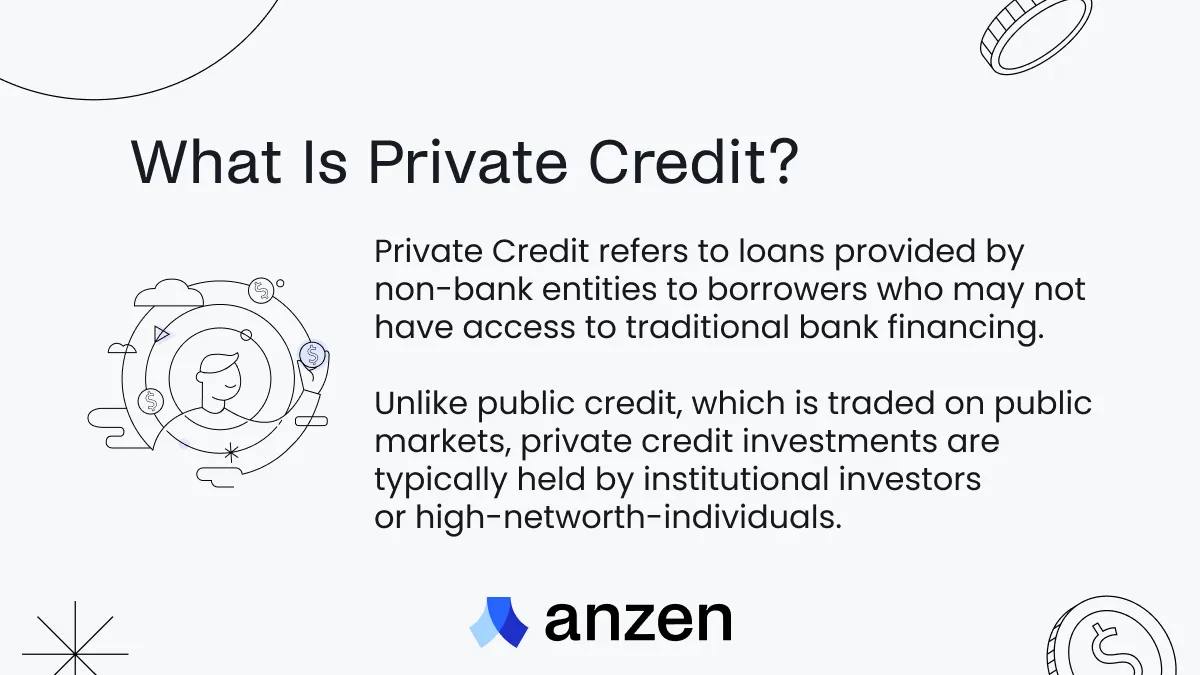· 3 min read
Private Credit: Unlocking Opportunities for Investors
Private credit has emerged as a dynamic and lucrative investment opportunity, providing investors with an alternative to traditional bank lending.
A primer on Private Credit
Private credit has emerged as a dynamic and lucrative investment opportunity, providing investors with an alternative to traditional bank lending. This primer aims to shed light on what private credit is, its historical context, and how investors can get involved in this promising asset class.
What is Private Credit?
Private credit refers to loans or debt instruments provided by non-bank entities to borrowers who may not have access to traditional bank financing. These borrowers can include middle-market companies, real estate developers, or even individuals seeking alternative lending options. Unlike public credit, which is traded on public markets, private credit investments are typically held by institutional investors or high-net-worth individuals.
 Private Credit is typically held by institutional investors, or high-net-worth individuals. It refers to any debt that is not traded on the public markets
Private Credit is typically held by institutional investors, or high-net-worth individuals. It refers to any debt that is not traded on the public markets
The Historical Context
The origins of private credit can be traced back to the 1980s when the lending landscape underwent a significant shift. Increased regulatory scrutiny, coupled with tighter lending standards, led banks to withdraw from certain market segments. This created a void that alternative lenders stepped in to fill. Over time, private credit evolved as an attractive option for borrowers and investors alike due to its flexibility, higher potential returns, and ability to fund niche projects.
Getting Involved as an Investor
Investors seeking exposure to private credit can explore various avenues, including direct lending, private debt funds, tokenized private credit, or participation in peer-to-peer lending platforms. Here are a few ways to get involved:
- Direct Lending: Investors can directly lend money to companies or individuals, negotiating terms and interest rates. This approach offers greater control and potential for higher returns but requires thorough due diligence and credit analysis.
- Private Debt Funds: Investing in private debt funds allows investors to pool their capital with other like-minded individuals or institutional investors. These funds, managed by experienced professionals, offer diversified portfolios of private credit investments across different sectors, reducing risk.
- Tokenized Private Credit: Invest through on-chain platforms that tokenize RWA’s such as private credit. Lend stablecoins to businesses and funds that diversify lending across different pools. By being on-chain, transactions are more transparent, allowing investors more security and choices into lending options.
- Peer-to-Peer Lending Platforms: Online platforms connect investors directly with borrowers, eliminating intermediaries. These platforms provide access to a range of private credit opportunities, enabling investors to select loans based on risk appetite and desired returns.
Considerations for Investors
Before venturing into private credit, investors should consider several factors:
- Risk and Reward: Private credit typically offers higher yields compared to traditional fixed-income investments, but it’s important to assess the creditworthiness of borrowers and understand associated risks.
- Due Diligence: Thoroughly evaluate borrowers, their financial health, and the underlying assets backing the loans to mitigate potential default risks.
- Diversification: Spreading investments across different borrowers, sectors, and geographies helps reduce concentration risk, or use a platform that creates diversified pools.
- Investment Horizon: Private credit investments may have longer lock-up periods, so investors should align their expectations and liquidity requirements accordingly.
Private credit presents an opportunity for investors to diversify their portfolios and potentially generate attractive risk-adjusted returns. By understanding what private credit is, its historical context, and the avenues available for investment, investors can make informed decisions and navigate this evolving asset class successfully. As always, conducting thorough due diligence and seeking advice from financial professionals can help investors navigate the nuances of private credit investments.